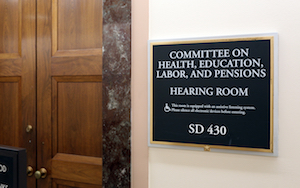
 The Senate Health, Education, Labor and Pensions (HELP) Committee is set to move forward on legislation intended to build off the House-passed SECURE Act 2.0.
The Senate Health, Education, Labor and Pensions (HELP) Committee is set to move forward on legislation intended to build off the House-passed SECURE Act 2.0.
After formally introducing the “Retirement Improvement and Savings Enhancement to Supplement Healthy Investments for the Nest Egg” (RISE & SHINE) Act on June 7, the committee announced that it will hold a markup on Tuesday, June 14 to consider the legislation.
Sens. Patty Murray (D-WA), chair of the Senate HELP Committee, and Richard Burr (R-NC), the committee’s ranking Republican, released their draft bipartisan legislation May 26 and asked for feedback from interested stakeholders.
The package is intended to build off the Securing a Strong Retirement Act of 2021 (SECURE 2.0), which the House of Representatives passed in March, as well as the Retirement Improvement and Savings Enhancement (RISE) Act introduced in the House and the Retirement Security & Savings Act introduced by Sens. Ben Cardin (D-MD) and Rob Portman (R-OH).
Similarities and Differences
While the RISE & SHINE Act shares some similarities with the aforementioned bills, it also diverges in certain ways from SECURE 2.0. Probably the biggest difference is that the RISE & SHINE Act does not include the mandatory auto-enrollment provision for business with more than 10 employees included in SECURE 2.0, but instead looks to include an automatic reenrollment provision for every three years.
RISE & SHINE also includes an emergency savings component of up to $2,500 that would be linked to DC plans, whereas SECURE 2.0 does not include such a provision.
Other provisions in RISE & SHINE that SECURE 2.0 does not include are:
- allowing some incidental plan design expenses to be paid from plan assets;
- directing the Treasury and Labor departments to amend regulations to permit DC plan sponsors to consolidate certain required participant notices; and
- clarifying that plans filing Form 5500 under a Group of Plans arrangement need only to submit an audit opinion if they have 100 participants or more.
Changes in SECURE 2.0 that RISE & SHINE does not include are:
- enhancing the credit for small employer retirement plan startup costs;
- enhancing the Saver’s Credit by simplifying the credit rate;
- increasing the catch-up contribution limit for those ages 62, 63 and 64;
- treating student loan payments as elective deferrals for purposes of matching contributions;
- removing required minimum distribution barriers for life annuities; and
- implementing a retirement savings lost and found database.
SECURE 2.0 also includes a number of revenue raisers that are not contained in RISE & SHINE.
It’s important to remember that the is the first step in the Senate’s consideration of counterpart legislation to the House-passed SECURE 2.0 and that the legislation will likely undergo additional changes as it moves through the legislative process.
What’s more, the Senate Finance Committee, which has jurisdiction over the Internal Revenue Code and works with the Senate HELP Committee on various retirement issues, has yet to release a proposal, but plans to do so in the coming weeks.
- Log in to post comments
